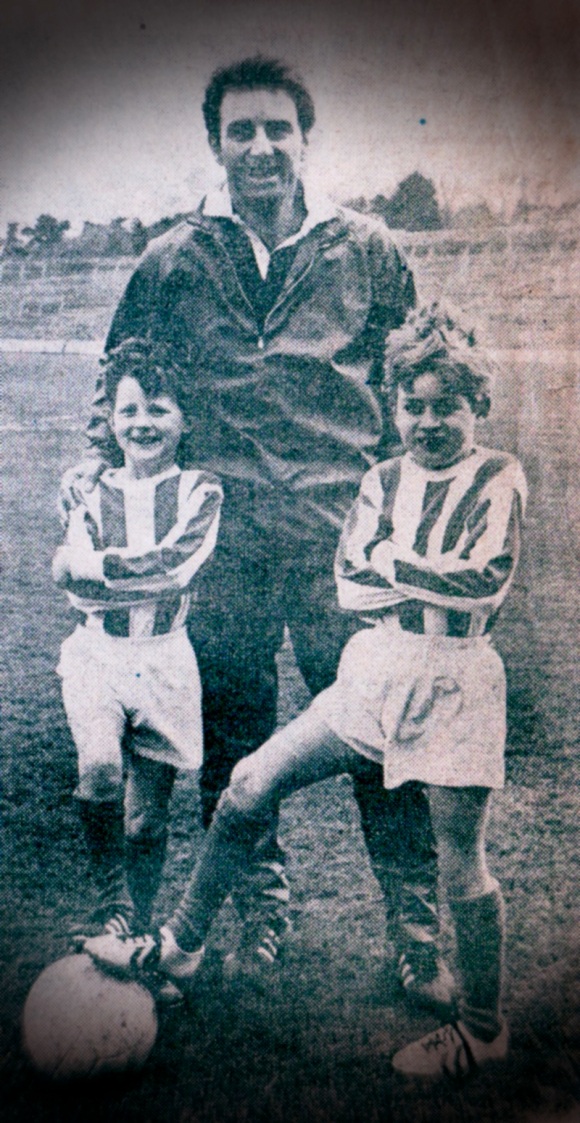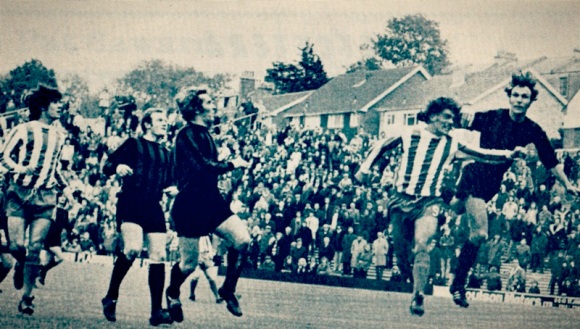In a two-part article by Goal! magazine’s Nick Harling in March 1973, Brighton manager Pat Saward surveyed the wreckage from a disastrous season in the Second Division. Having led the Albion out of the Third Division in 1972, he found his team torn apart. The Sussex side stood 18th on 4th November 1972 as they stretched an unbeaten run to five matches. However, then came that astonishing thirteen match losing streak that stretched to the end of January:
Imagine a runaway lorry careering down a hill without brakes.
Then you’ve put yourself in the position of Brighton manager Pat Saward, whose team are propping up the rest of the Second Division after a catastrophic run of reverses that makes an immediate return to the Third Division almost as big a certainty as the fact that the lorry will eventually crash.
Comparing his team’s current plight to that of a unstoppable truck, Saward, who won an F.A. Cup medal with Aston Villa 16 years ago, says: “It’s a freak thing.
Even the worst sides get a point here and there. A run like this is unnatural. In 20 years’ football I’ve never known anything like it. We have just been praying it will stop.”
Few managers can have experienced such a swift change from glory to utter despair as Saward has over the past few months. It was all so rosy on the night of May 3 last year when, with a capacity 34,766 crowd crammed into the Goldstone Ground and thousands more locked outside, Brighton drew 1-1 with Rochdale to clinch promotion behind Aston Villa.
Refusing two offers to go elsewhere in the summer, Saward stayed at Brighton, saying: “I was very very confident for the future. This club has so much to offer. I could see my ambitions coming to fruition. I was super optimistic.” He was super optimistic because with 82 goals, Brighton were the third highest scorers in the Football League. With forwards such as the tricky ever-present Peter O’Sullivan, Northern Ireland internationals Willie Irvine and Bertie Lutton and the much sought-after Ken Beamish on their staff, Brighton’s attack had shown itself so devastating that there seemed no reason why it need be anything but only slightly less effective in the Second Division. And with the early season purchase of £30,000 Barry Bridges from Millwall there seemed strength in depth in that department at least.
What then has gone wrong? Why has the supply of goals, which came so readily in the Third Division, suddenly dried up? Why did the goalscoring ability of Irvine and Kit Napier diminish to such an extent that Saward found it necessary to transfer both players back to the Third Division Irvine to Halifax, Napier to Blackburn.
Why is the attack, which functioned so powerfully last season, scoring very nearly two goals a game, compared to one a match so far this term, doing so badly? And several questions must be asked about the defence as well. Last season it allowed opposing teams a meagre 47 goals.
Norman Gall, ever present last season has been dropped and John Napier, also a regular, has been allowed to move to Fourth Division Bradford City, because they were incapable of plugging so many gaps. In the places of these two, Saward has given Ian Goodwin a 21-year old 14-stone centre half, whom he has recently appointed captain, and young Steve Piper the opportunities to halt a slide that has astounded soccer.
As two useful defenders, George Ley and Graham Howell, were also added to Brighton’s staff early in the season, Brighton’s slump is one that has confounded their manager. But Saward is nevertheless honest enough to say: “I didn’t forsee the snags and the type of league the Second Division was. But now I know. It’s the hardest division of the four. Everyone is fighting either to stay in or get out.
“It’s a hell of a hard division. It’s a mixture of the First and Third. It’s good and very hard football. They don’t give you an awful lot of time to play. It’s a division governed by fear because to drop out of it is not good, while to get out at the top is fantastic. I didn’t believe the gap would be so different. Teams are so well organised and supplement their lack of ability with tremendous defensive play. It’s very hard to get results.”
He can say that again, although when Brighton drew nine of their first 18 games, and won two of the others, they at least hinted at hopes of consolidation, which have not been fulfilled.
Recalling that start, Saward says: “I’m not suggesting we were going to set the League alight but at least we seemed to be getting somewhere.”
As defeat has followed defeat for Brighton, manager Pat Saward has seen the effect such a run can have on players.
He says: “It starts when you’re missing goals. I’m not making excuses saying it’s all been had luck, but speaking as an explayer I know that when you lose by a freak goal, it can be sickening. When you come to the next match and have the bulk of it but still lose the players start sowing seeds of doubt in their own minds.
“They start to anticipate mistakes before they happen. The longer the sequence goes the worse it becomes. The players’ minds are shackled. They run hard, chase and harrass but have nothing to show for it. Then when they’ve nothing to show for weeks they start to tie up.
A lucky break might stop it or a new player might stop it. Otherwise you carry on with what you’ve got. You take a hell of a mental bashing. It’s very hard to regenerate week after week but you have to hang on to something. It’s no good just thinking hack to last year and promotion.
“To me the most important thing is the attitude of mind. Players should have an arrogant attitude, an attitude that they’re going to do well even when the chips are down. But some types are destroyed. These are the ones who succumb and want to rely on other people.
Here we’ve got some great boys, but I wish to God some of them had more determination.”
It was with that desire in mind that Saward gave part of the huge responsibility of captaining his sinking ship to 21 year-old Ian Goodwin, because: “He’s a hell of a competitor. He’s a bloody bad loser and wants to go places. He reflects the new mood around here.” That “new mood” is mainly being provided by new joint chairmen Mike Bamber and Len Stringer, whose board have just ploughed £70,000 into renovating the place, changing it from what Stringer described as “a real slum,” installing new dressing rooms, players’ facilities and offices.
One of these offices will shortly be used by enthusiastic 41-year-old Bamber, who with his business partner Norman Hyams, also a Brighton director, is forming a property development company which will be based within the football club.
“We will have 51 per cent of the shares, the club 49 per cent,” explains Bamber.
“It’s a unique idea. It must be a good thing for Brighton. It’s something I’ve been thinking about for a long time now.
If Pat Saward wants a player we’ll find the money. He has 100 per cent backing from the board.
“Our new policy is to go in with young players. It’s never been the policy at Brighton before to bring on our own youngsters, but now we’ve got some around like Steve Piper, who is a fabulous player.”
It has been to these youngsters’ considerable misfortune that with their first real taste of League football, they have been saddled with trying to transform such a struggling outfit, but this does not detract from Bamber’s intense optimism for what they can do for Brighton in the future.
Asking “Where else would a team get cheered off the field by their own supporters after losing their tenth game in a row?”, Bamber adds without a sign of tongue in cheek: “There’s no doubting it – First Division here we come.” Although Brighton may well have to climb back again via the Third to give that forecast any chance of materialising, both Bamber and Saward realise that the crowd potential of the area is so vast that the town can support a top club.
And Saward certainly will not be content until such a prospect, unlikely though it seems at the moment, becomes reality.
He took over nearly three years ago and promised then: “Give me ten years and I’ll have Brighton in the First Division.” Now Saward says: “I haven’t lost any enthusiasm. I’ve had my hopes dampened slightly, but one overcomes that.” Unlike many of his contemporaries, who might conceal their deepest fears with idle boasts, Saward says: “We’ve one hell of a hard job to stay up. We are going to need an awful lot of luck, but we deserve some breaks. If we get the breaks then we could just do it.
“Okay we’ve got to face facts. If we go down, thinking that the Third Division is the end of the world, that’s the end of Brighton. This club has got to be built for the future. I want to put Brighton on the map.”
If the miracle that everyone connected with the popular coastal club so desperately wants, does arrive and Brighton do win all their remaining games to stay up, Saward will have more chance of achieving his long-term aim. And he says: “Nothing is lost until we run out of points.”
Having halted the run of defeats with a 2-0 victory over Luton in early February 1973, Albion lost their following two fixtures. However, out of the wreckage, Brighton then began to show some form, winning four and drawing two of the next six League games. But there was to be miracle, and a 3-0 defeat at Easter in April at eventual champions Burnley sealed Albion’s fate.



























